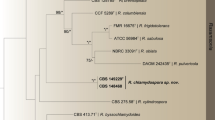Abstract
Two striking fungi, isolated from soils from the island of Hachijo-jima in Japan, are described and illustrated. One of these represents a new species ofTalaromyces (Ascomycetes), for which the nameTalaromyces hachijoensis is proposed. The new species is distinctive among all other recognized species in its restricted growth on common media, yellow ascomata characterized by asci developing in chains, striate ascospores, and the absence of an anamorph. The other isHeterocephalum taiense, a rare hyphomycete which has only previously been recorded from lvory Coast soil and probably from Panama soil.
Similar content being viewed by others
Literature cited
Anonymous. 1992. C.A.B. International Mycological Institute, Catalogue of the Culture Collection, 10th ed., C.A.B. International, Wallingford, Oxon, U.K.
Barron, G. L. 1968. The genera of hyphomycetes from soil, Williams and Wilkins, Baltimore.
Farrow, W. M. 1954. Tropical soil fungi. Mycologia46: 632–646.
Iijima, T., Kakishima, M. and Otani, Y. 1985. A new species ofExobasidium onCinnamomum japonicum Sieb. Trans. Mycol. Soc. Japan26: 161–167.
Indoh, H. and Oyatsu, A. 1965. OnHeterocephalum aurantiacum Thaxter, newly found in Okinawa. Trans. Mycol. Soc. Japan5: 79–82. (In Japanese.)
Kornerup, A. and Wanscher, J. H. 1978. Methuen handbook of colour, 3rd ed., Eyre Methuen, London.
Matsushima, T. 1975. Icones microfungorum a Matsushima lectorum, Matsushima Fungus Collection, Kobe.
Matsushima, T. 1983. Matsushima mycological memoirs. No. 3. Matsushima Fungus Collection, Kobe.
Morris, E. F. 1963. The synnematous genera of the Fungi Imperfecti, Western Illinois Univ., Biol. Sci. Publ. No. 3, Macomb, Illinois.
Persiani, A. M. and Maggi, O. 1986. A new species ofHeterocephalum from Ivory Coast soil. Trans. Br. Mycol. Soc.87: 631–635.
Pitt, J. I. 1979. The genusPenicillium and its teleomorphic statesEupenicillium andTalaromyces, Academic Press, London.
Raper, K. B. and Fennell, D. I. 1952. Two noteworthy fungi from Liberian soil. Amer. J. Bot.39: 79–86.
Rayner, R. W. 1970. A mycological colour chart, Commonwealth Mycological Institute, Kew and British Mycological Society.
Stolk, A. C. and Samson, R. A. 1971. Studies onTalaromyces and related genera I.Hamigera gen. nov. andByssochlamys. Persoonia6: 341–357.
Stolk, A. C. and Samson, R. A. 1972. The genusTalaromyces. Studies onTalaromyces and related genera II. Studies in Mycology, No. 2, pp. 15–6. Centraalbure voor Schimmel-cultures, Baarn.
Thaxter, R. 1903. New or peculiar North American Hyphomycetes. III. Bot. Gaz.35: 153–159.
Watanabe, T. 1989. Soil fungal flora in Hachijo-jima island. Trans. Mycol. Soc. Japan30: 427–435.
Watanabe, T. 1990. Three newNectria species from Japan. Trans. Mycol. Soc. Japan31: 227–236.
Watanabe, T. 1992.Taeniolella phialosperma sp. nov. from Japan. Mycologia84: 478–483.
Watanabe, T. 1994. Two new species of homothallicMucor in Japan. Mycologia84: 691–695.
Author information
Authors and Affiliations
About this article
Cite this article
Yaguchi, T., Someya, A. & Udagawa, Si. New and rare microfungi from the island of Hachijo-jima. Mycoscience 37, 157–162 (1996). https://doi.org/10.1007/BF02461340
Received:
Issue Date:
DOI: https://doi.org/10.1007/BF02461340




